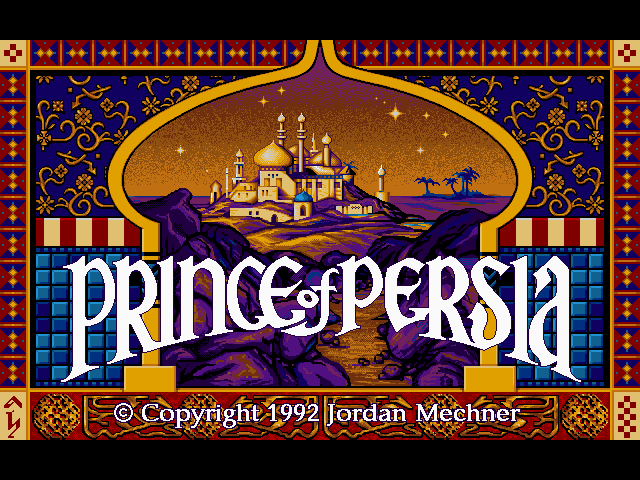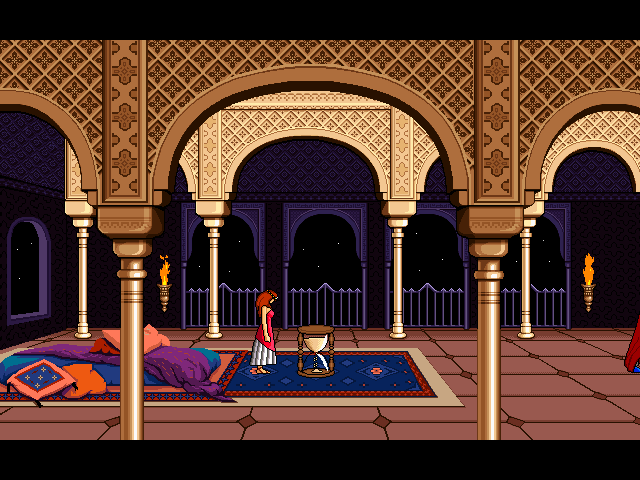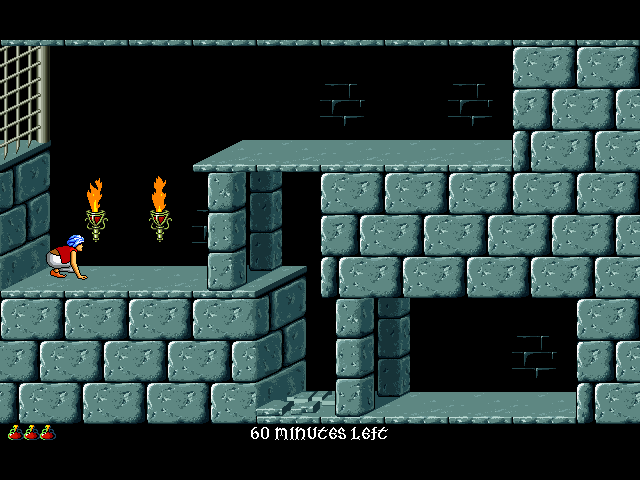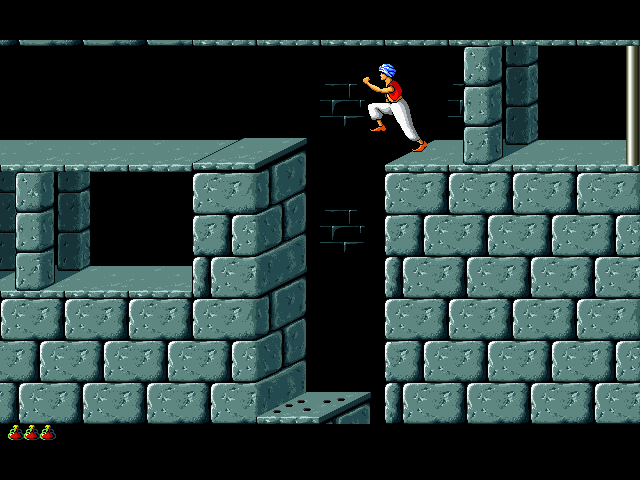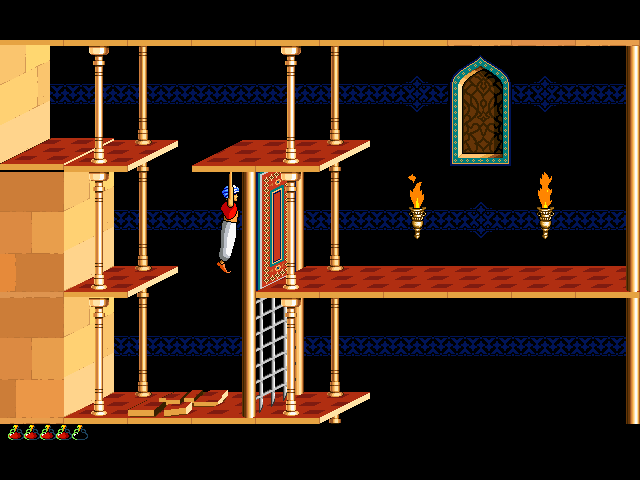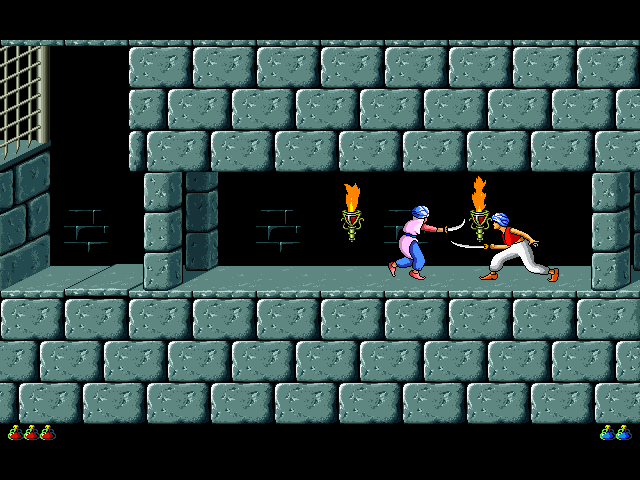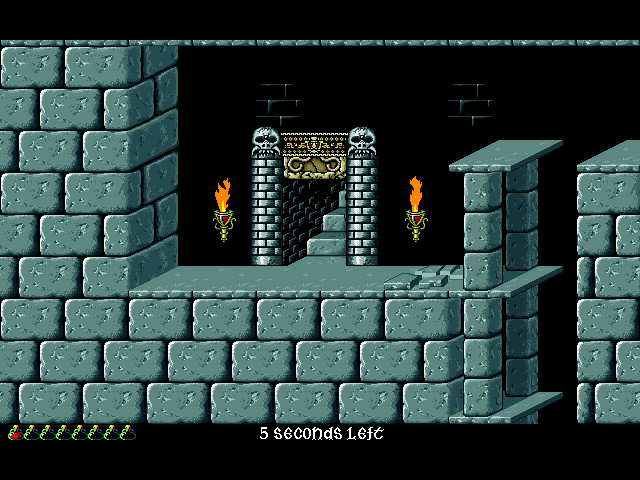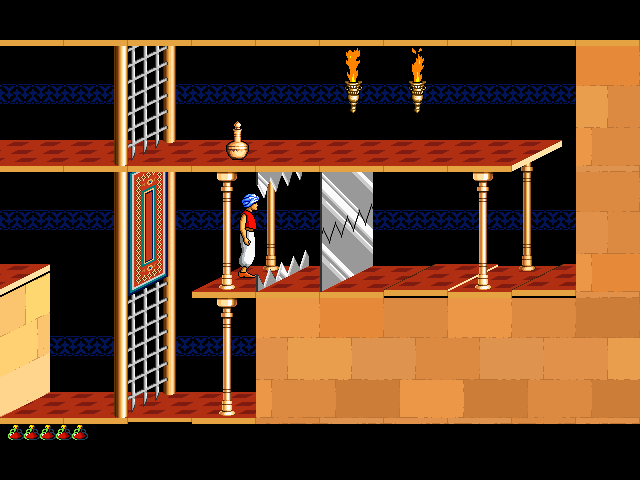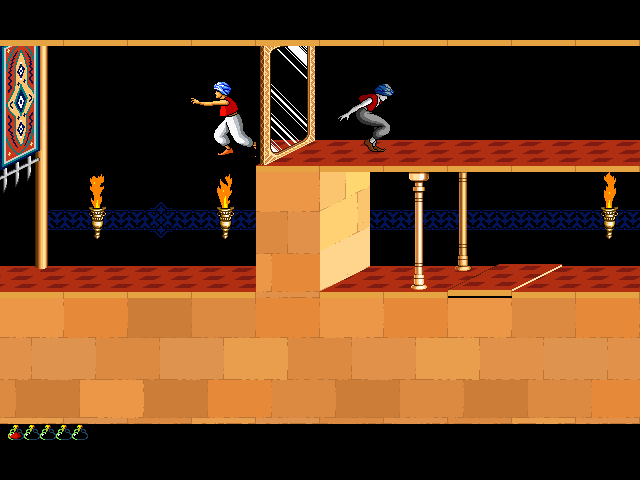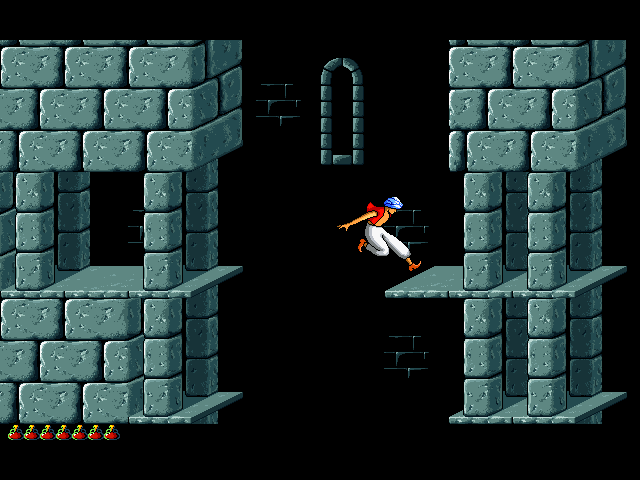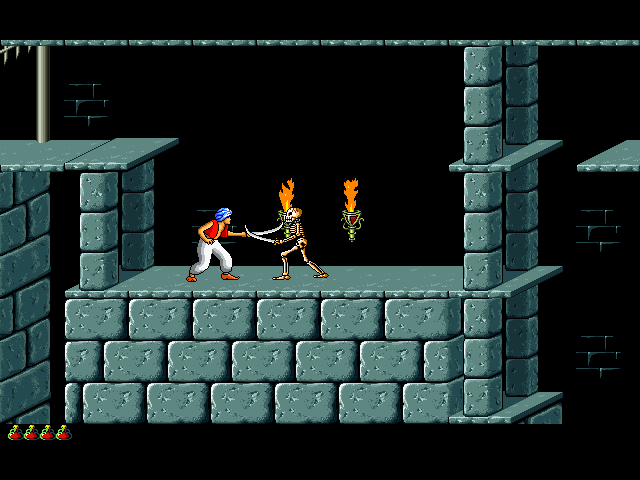Prince of Persia – Broderbund Software/Jordan Mechner - 1992 - First time playing?: Yes!
In spite of my constant comparisons to this game in my previous Tomb Raider review, I had never actually sat down to play through the original Prince of Persia. I had played through the PS2 game, Prince of Persia: The Sands of Time, but the most I had played of the original Prince of Persia was two levels, if even that. It had always intimidated me, from its strict time limit to its weird control scheme to the unconventional style of combat. In the spirit of my claims about Tomb Raider being intimidating and clunky at first but worth the effort of adapting to it for something unique and engaging, I felt inspired and decided now was as good a time as any to finally take a crack at Prince of Persia. And lucky me, it has a Mac port!
In the absence of the sultan, the vizier Jaffar has overthrown the kingdom and rules with an iron fist. The only thing in between him and total conquest is the princess's hand in marriage. The princess refuses, and as such she is given an ultimatum; marry Jaffar within the hour or be executed instead. The sands of time are trickling through the hourglass, and the only person who can save the princess, the man she truly loves, has been thrown into prison. As the future Prince-to-be, you must escape the dungeons and make your way to Jaffar, defeat him in combat and save the princess within the hour.
Starting the game we see the Future Prince kicked into a cell and gameplay immediately begins. Fortunately for both you and the princess's chance for survival, the floor is crumbling apart and will reveal an escape route if you run over it. This room also gives you a chance to play around with the controls a bit. You can try running left and right at full speed, or try holding down the walk key to carefully and slowly tiptoe around to better position yourself or prevent you from falling off ledges. There's a ledge that you can practise climbing up and down as well, which also gives you just enough room to figure out the timing for the running jump. Much like Tomb Raider, jumping with a running start is the way to get the most distance in your jump, but here it's even easier to mess up the input of. No backwards hop input to have you jump back the exact distance you need to get a running start for a long jump here, instead you have to run from at least three tiles away from the ledge you want to jump from and then time yourself starting to hold the jump button you’ve closed that gap down to two tiles between you and the ledge. Much like Tomb Raider it's fairly reliable once you have a feel for the timing but it can trip you up a lot early on.
Overall the controls again take some getting used to, but I think even at the best of times they feel a bit slippery. There's some awkward quirks such as how if you walk up to the edge of a platform and then let go of the walk key you'll then fall off the ledge as if you just slipped, even while still standing completely stationary on the solid ground of that ledge. In a similar vein, walking to the edge of a platform instead of running prevents you from falling off it, but only once. If you move towards the ledge again, the future prince will fall off. I tend to forget that this is even a mechanic until I'm trying to jump forward from the edge of a platform and when attempting to press the arrow key and the jump key at the same time I accidentally tap the arrow key slightly earlier and fall to my death. Even just moving around can feel a bit weird because of how far the future prince will run with the lightest input. If you're not holding that walk key, then lightly tapping an arrow key for a single game will result in the future prince running across the distance of two tiles, while even with the walk key held down it can be tricky to get things lined up perfectly (though this is alleviated by generous hitboxes on things you need to interact with).
So I definitely have a lot of gripes with the controls, but make no mistake, they do work, and they can feel pretty satisfying when you get a good flow going. The smooth rotoscoped animation combined with some weighty and realistic physics (well, realistic for the time anyway) makes those perfectly timed running jumps that end in you just managing to grab onto the edge of a platform a joy to pull off. Back in 1989 I don't think you'd find any other game out there that conveys the weight of a human being via game mechanics and control nearly as well as Prince of Persia.
After busting out of your cell, your first objective is finding a sword. On the way to the sword you'll discover another core mechanic, that being pressure plate tiles. Certain tiles may appear slightly misaligned if you look closely at them, indicating that the tile in question is a pressure plate. This combined with the crumbling tiles, like the one you broke to escape the cell, make up the game's primary puzzle mechanics. Certain pressure plates will open up locked doors for you when you step on them, but other pressure plates will slam those doors shut again. Sometimes the pressure plate opens the door permanently, other times it's only open for a limited amount of time. As for the crumbling tiles, as well as requiring some caution to make sure you don't fall to your death, they're also used for puzzles to get you thinking about your routing. After all, once a platform crumbles, it's gone, potentially resulting in being locked out of the route forward as you needed that crumbling platform to do a running jump from. Creatively, the crumbling tiles can actually also be used to your advantage, since the rubble from the tile landing on top of a pressure plate will press it down permanently. Crumbling tiles look identical to all of the other solid tiles, but jumping on a tile or bumping your head on solid tiles will cause nearby crumbling tiles to shake a little, letting you know in advance that they'll crumble without relying on trial and error. Simple as they are, I really like these puzzles and appreciate how they require you to think about the level design in unique and different ways, experimenting with less direct routes and such.
Once you've got the sword, it's time for combat. The future prince will automatically draw your sword once you approach a guard, resulting in a fencing duel. Move back and forward with the left and right arrow keys, stab with your sword with the action key and use the up arrow key to parry attacks. These fights kind of play like an early fighting game, right down to the future prince always facing his opponent, but they are for the most part unfortunately shallow. Nearly every fight in the game can be won by simply standing still, waiting for your opponent to move in range and then instantly stabbing them before they have a chance to strike you. There's a grand total of three fights in the entire game where this strategy doesn't work, two of which are the last two bosses in the entire game. Thankfully fights are brief and not too major of a pace breaker, plus you might want to try and get a bit more fancy to fight common enemies quicker by playing more aggressively, closing in, parrying and getting some rapid stabs in. After all, you're on a timer.
Let's talk about that time limit finally, the most intimidating aspect of this game to me for over a decade. The time limit of a single hour to beat the full game is extremely strict and doesn't allow much room for error. I do understand what the designer was going for to an extent however. Games of this era were designed with the intention of repeated replays, so as you play the early levels more and more you'll optimise your routing through those stages, giving you far more time for the later more difficult and unknown levels, allowing you some freedom to experiment and figure things out. The prince has unlimited lives, if he dies he'll just respawn back at the start of the level, but your timer won't reset, so the more you die the more time you're wasting. This also however results in not all deaths having an equal penalty. In games with traditional lives systems, you die at any point in the game, you lose a single life. In Prince of Persia however, if you die right at the end of a five minute long stage, that's going to be a far more crushing loss than if you died five seconds into the stage. Dying the same way can cost much more depending on where you are at the time of death, making things feel unbalanced. Thankfully, there is a save system, something I completely missed when I played this game in the past. With a command-s shortcut you can save the game at the start of any level and reload it as many times as you want without penalty. How much time you had left at the time of saving is also saved, allowing you to start the level over without that lost time from your failed attempts. I will confess to playing this way, and honestly just as well too. Even with save reloading every time I died, I still finished my first run with only five seconds left on the clock (although on retrying the final level I did it with six minutes left) . With the large maze-like level designs and puzzle solving and such, an hour is just not enough to give the player breathing room to figure things out. Given the slower, more cautious pacing of this game compared to other platformers of the era, it feels odd to add a time limit to discourage that cautious pacing that makes the game unique.
There's a lot that is frustrating about Prince of Persia but I also absolutely had a good time and found much of the game very satisfying and an impressive achievement for the time. Time limit aside, the level design is very good and engaging. The puzzles add a bit of depth to what could otherwise be fairly straightforward platforming and exploration is rewarded by hidden potions that permanently increase your max HP. The spike traps and guillotine doors add some extra challenge too, requiring caution and good timing to avoid getting gruesomely skewered by. The guillotine trap death animation actually made me jump a little by how sudden and unexpectedly gory it was. These traps can also be utilised in combat, as knocking enemies into them will be an instant death for them and an instant win for you.
In addition, for as simple as the story is on paper, yet another "save the princess" adventure like so many other 80s games, it actually has some interesting developments as you play through the game which lead to some memorable and charming setpieces. The absolute highlight is the point where you jump through a mirror which causes your shadowy reflection to be separated from your body and have a mind of his own. Throughout the game he'll be showing up and messing with you constantly, even stealing one of those HP-increasing potions right in front of you before you have a chance to get it. Even the princess gets some good moments, with short intermission cutscenes showing what she's up to in her holding room while the future prince is escaping the dungeons. The atmosphere also stands out, quiet dungeons with the soft sounds of your footsteps and occasional crumbling platforms making up most of the audio, with occasional heroic musical stings as you defeat an opponent in combat or complete a level.
The Mac port is solid with a few quirks here and there. The graphics have been redrawn in higher resolution with more colour and detail and they look very pleasing, though the bright and cartoony style compared to the more grimy colour schemes of other ports may not be to everyone’s tastes. The biggest issue is that the Mac port runs a bit slower than the other versions, giving the game a sluggish and floaty feeling. Thankfully in recent years a fan-made patch has fixed this issue, allowing the game to be played at full speed. If you’re into gaming history and have the patience to learn some unconventional and potentially frustrating mechanics, I highly recommend giving one of the many versions of Prince of Persia a try as you’re rewarded with a unique, groundbreaking and memorable adventure that still has value and appeal today. It’s been ported to nearly everything under the sun so you have plenty of options.
- Page written by MSX_POCKY, 22nd April 2023
